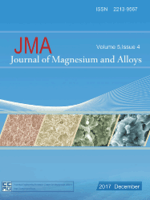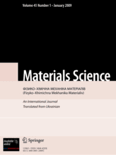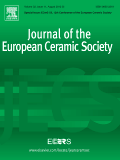
Tungsten
Scope & Guideline
Unveiling the potential of tungsten for innovative applications.
Introduction
Aims and Scopes
- Materials Engineering and Synthesis:
Research in this area covers the development and fabrication of tungsten-based materials, including composites and alloys, utilizing various synthesis techniques such as spark plasma sintering and additive manufacturing. - Electrochemical Applications:
The journal extensively features studies on the electrochemical behavior of tungsten and its compounds, particularly in energy storage systems such as lithium and sodium-ion batteries, as well as water splitting and catalysis. - Characterization and Performance Analysis:
A significant focus is placed on the characterization of tungsten materials under various conditions, including thermal stability, corrosion resistance, and mechanical properties, providing insights into their performance in practical applications. - Environmental and Catalytic Applications:
The journal addresses the use of tungsten in environmental catalysis, including its role in the degradation of pollutants and carbon dioxide reduction, highlighting its potential in addressing environmental challenges. - Advanced Theoretical and Computational Studies:
Research utilizing theoretical and computational methods to predict and analyze the properties of tungsten materials, including modeling radiation damage and exploring electronic structures, is also a key focus.
Trending and Emerging
- Nanostructured Tungsten Materials:
Research on nanostructured tungsten materials is gaining traction, focusing on their enhanced properties for applications in energy storage and catalysis, reflecting a broader trend towards the miniaturization and optimization of materials. - Tungsten in Energy Storage Systems:
There is an increasing emphasis on tungsten's role in next-generation energy storage systems, particularly lithium-sulfur and sodium-ion batteries, highlighting its potential to improve performance metrics such as capacity and cycle stability. - Sustainable and Green Chemistry:
Emerging themes include the use of tungsten in environmentally friendly processes, such as photocatalytic CO2 reduction and the valorization of waste materials, aligning with global sustainability goals. - Integration with Advanced Materials:
The exploration of tungsten's integration with other advanced materials, including polymers and metal-organic frameworks, is trending, suggesting a shift towards hybrid systems that leverage the strengths of multiple components. - Computational Materials Science:
The application of computational methods to study tungsten materials, including machine learning and simulations, is on the rise, indicating a trend towards predictive modeling and accelerated discovery in material science.
Declining or Waning
- Basic Research on Tungsten Properties:
There is a noticeable reduction in publications focused solely on the fundamental physical and chemical properties of tungsten. This shift may indicate a move towards more application-driven research. - Traditional Applications in Nuclear Technology:
Research related to the traditional use of tungsten in nuclear applications seems to be waning, possibly due to advancements in alternative materials and technologies that offer better performance or safety. - Single-Material Studies:
There is a decline in studies that solely investigate tungsten without incorporating composite or hybrid materials, as the field increasingly favors multi-component systems that enhance performance.
Similar Journals

Polymer-Plastics Technology and Materials
Redefining the Landscape of Polymer EngineeringPolymer-Plastics Technology and Materials is a premier academic journal published by Taylor & Francis Inc., dedicated to the dynamic fields of chemical engineering, materials chemistry, and polymers and plastics. With an impact factor that reinforces its reputation, this journal is strategically indexed in Scopus, ranked notably within its categories (Q2), showcasing its influence and relevance in the academic community. Since its inception in 2019, the journal has served as an essential platform for researchers, professionals, and students to disseminate innovative studies and advancements in polymer science and materials technology. As an Open Access publication, it ensures that cutting-edge research is accessible to a global audience, fostering collaboration and knowledge sharing in the material sciences. Located in the United Kingdom, Polymer-Plastics Technology and Materials continues to enhance the dialogue within the industry, addressing critical challenges and exploring emerging trends that shape the future of polymer and plastics technologies.

Journal of Magnesium and Alloys
Exploring Innovations in Magnesium and AlloysThe Journal of Magnesium and Alloys is a prestigious, peer-reviewed academic publication dedicated to advancing the field of materials science, particularly focusing on magnesium and its alloys. Published by KEAI PUBLISHING LTD since 2013, this Open Access journal enables unrestricted dissemination of research findings, enhancing global collaboration among researchers, professionals, and students. With an ISSN of 2213-9567 and a significant impact factor, it has established itself in the upper quartiles (Q1) of both the Mechanics of Materials and Metals and Alloys categories, ranking #3 out of 176 and #9 out of 398 respectively according to Scopus. The journal aims to provide a forum for the latest advances in the understanding, production, and application of magnesium alloys, fostering innovation and sustainable practices within the materials engineering community. Based in Beijing, China, the journal is committed to bridging gaps in current knowledge and driving future research directions through its high-quality publications.

Korean Journal of Metals and Materials
Connecting Researchers in the World of Metals and MaterialsWelcome to the Korean Journal of Metals and Materials, a premier publication dedicated to advancing research in the interdisciplinary fields of metals and materials science. Published by the Korean Institute of Metals and Materials, this journal aims to foster the dissemination of innovative findings and significant developments across various domains, including electronic, optical, and magnetic materials, metals and alloys, as well as modeling, simulation, and surface coatings. With a commendable Q3 quartile ranking in several relevant categories as of 2023, it serves as a vital resource for researchers, professionals, and students interested in the latest scientific trends and technological applications. The journal has successfully converged from 2007 to 2024, showcasing a rich archive of knowledge. Engaging with this publication gives readers the opportunity to stay updated with critical advancements and enhances collaboration within the vibrant materials science community. Access is available through various platforms, ensuring that our content is widely accessible to all those striving for excellence in the field.

INTERNATIONAL JOURNAL OF REFRACTORY METALS & HARD MATERIALS
Bridging theory and application in materials innovation.INTERNATIONAL JOURNAL OF REFRACTORY METALS & HARD MATERIALS, an esteemed publication by Elsevier Science Ltd, stands at the forefront of materials research, focusing on the development and application of refractory metals and hard materials in various engineering fields. With an impressive impact factor and recognition as a Q1 journal across several categories including Ceramics and Composites, Materials Chemistry, and Mechanical Engineering, it serves as a vital resource for researchers, professionals, and students alike. The journal has been continuously publishing high-quality research since its inception in 1982, with a convergence of developments spanning through to 2024. Its Scopus rankings further emphasize its significance, boasting ranks in the top percentiles of relevant scientific fields. Although it operates under a subscription model, the depth and rigor of the research published within its pages ensures that it remains an invaluable tool for those pursuing innovation and exploration in materials science.

Functional Composites and Structures
Transforming Ideas into Structural Solutions.Functional Composites and Structures is a prestigious academic journal published by IOP Publishing Ltd, dedicated to advancing the field of materials science with a focus on innovative composite materials and their structural applications. Established in 2019 and running through 2024, this journal uniquely bridges several disciplines, consistently ranking in the Q2 quartile across key categories including Ceramics and Composites, Electronic, Optical and Magnetic Materials, and Mechanics of Materials. With a commendable Scopus rank that places it within the top tiers of its field, the journal is instrumental for researchers, engineers, and scholars seeking to explore the latest developments in material properties, functionality, and applications. Although access options are not specified, the open-access nature of the journal promotes wider dissemination and engagement with cutting-edge research. As the demand for smarter, more efficient materials continues to grow, Functional Composites and Structures serves as a vital resource for fostering collaboration and driving innovation in material sciences.

C-Journal of Carbon Research
Unveiling the Future of Carbon Science and SustainabilityC-Journal of Carbon Research is an innovative and dynamic journal published by MDPI, situated in the picturesque city of Basel, Switzerland. Launched in 2015 and operating under an Open Access model, the journal aims to promote the dissemination of high-quality research related to carbon science, environmental sustainability, and renewable resources. With a current impact factor reflecting its growing influence in the field, the journal's standing is bolstered by its Scopus ranking, placing it in the 37th percentile in the Environmental Science category. It offers a platform for researchers, professionals, and students alike to engage with cutting-edge studies, reviews, and discussions that contribute to environmental science advancements. As the journal continues its convergence journey from 2022 to 2024, it remains committed to fostering scholarly exchange and interdisciplinary collaboration on pressing carbon-related challenges.

International Journal of Applied Ceramic Technology
Pioneering practical applications in ceramic technology.International Journal of Applied Ceramic Technology, published by WILEY, serves as a key platform for advancing the field of ceramics and composites with a rich focus on innovation and practical applications. With an ISSN of 1546-542X and E-ISSN 1744-7402, this journal has established its presence in multiple disciplines, indicated by its impressive Q3 rankings in Ceramics and Composites, Condensed Matter Physics, Marketing, and Materials Chemistry as of 2023. Covering research from 2004 to 2024, it provides a comprehensive repository of knowledge that aids in the understanding and development of materials. Although it lacks Open Access options, the journal maintains rigorous peer-review standards that ensure high-quality publications for researchers, professionals, and students alike. Given its scopus rankings, including a commendable #61 in Ceramics and Composites, this journal is pivotal for anyone looking to deepen their expertise and engage with the latest advancements in ceramic technology.

MATERIALS SCIENCE
Pioneering Discoveries in Condensed Matter Physics.MATERIALS SCIENCE, a prominent journal published by SPRINGER, serves as a vital resource for researchers, professionals, and students in the fields of materials science, mechanical engineering, and condensed matter physics. With its ISSN 1068-820X and E-ISSN 1573-885X, this journal has been dedicated to sharing innovative research since its inception in 1993, and it continues to publish groundbreaking findings through 2024. Although it operates as a traditional subscription-based journal, its ranking in the Q3 quartile across multiple scientific categories, including Condensed Matter Physics, Materials Science, Mechanical Engineering, and Mechanics of Materials, signifies its relevance and impact in the academic community. Notably, its Scopus classifications reveal a competitive standing among its peers, ranking within the 25th to 33rd percentiles across various engineering and physics disciplines. The journal remains a key platform for disseminating valuable insights, fostering collaboration, and advancing the understanding of materials science.

Acta Metallurgica Slovaca
Elevating the discourse in materials science and metallurgy.Acta Metallurgica Slovaca is a distinguished open-access journal published by SCICELL SRO that has been pivotal in the field of Materials Science and Metallurgy since its inception. With a robust commitment to disseminating high-quality research, this journal covers a wide array of topics within the scope of metals and alloys. Now indexed in Scopus, it ranks 82nd out of 176 in its category, reflecting a growing influence within the scientific community. With a quartile ranking of Q3 as of 2023, Acta Metallurgica Slovaca serves as an essential platform for researchers and professionals seeking to share innovative findings and developments in metallurgical science. Open access since 2013, it ensures that research is accessible to all, fostering collaboration and engagement across academia and industry worldwide. With a converged publication timeline extending from 2009 to 2024, this journal continues to play a crucial role in advancing knowledge and addressing contemporary challenges in the metallurgy sector.

Journal of the European Ceramic Society
Driving Progress in Ceramic ResearchThe Journal of the European Ceramic Society, published by Elsevier, is a premier academic periodical dedicated to the cutting-edge advancements in the fields of ceramics and composites, as well as materials chemistry. With an impressive impact factor that places it in the top quartile (Q1) of its category, it ranks #33 out of 317 in Materials Science and #16 out of 127 in Ceramics and Composites, showcasing its strong influence in the scientific community. Established in 1989 and set to converge until 2025, this journal serves as a critical platform for researchers and professionals to disseminate their findings, share ideas, and foster collaboration in the rapidly evolving area of ceramic materials. Although it does not offer Open Access options, the journal ensures rigorous peer review and maintains high standards for publication, making it an essential resource for students, academics, and industry experts who are pushing the boundaries of material science.